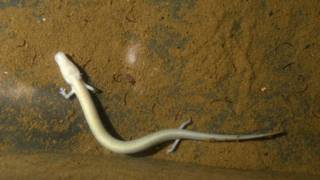 Image copyright Science Photo Library
Image copyright Science Photo Library in Slovenia, in the karst cave, which is annually visited by millions of tourists, a rare and unusual lizard, which has become a celebrity, hatches a few dozen eggs.
OLM – tailed amphibian family Proteus (also called olmom or blind salamander – by analogy with similar Texas amphibian) – inhabits the river caves of the Balkan Peninsula
it is believed that she lives sometimes. more than 100 years and lay eggs only twice a decade.
The female European Proteus, who lives in an aquarium karst Postojna cave in southwestern Slovenia, delayed 50-60 eggs. Three of them are already showing signs of growth.
No one knows how many amphibians can hatch from these eggs and even how long this process will take.
“Now it seems that there are three good candidate “, – says biologist Sasho Veldt
He and his colleagues made the eggs pictures with very long exposures in the dark cave to catch signs of tiny embryos
..” She began to lay eggs January 30 and still lays one or two eggs every day takes about 120 days to hatch offspring. “- he says
” amazing event “
This is a rough estimate, explains biologist, based on observations of a colony of Proteus, who lives with the 1950s in an underground laboratory in the French Pyrenees.
There they live in a little more warm water, its temperature is 11 ° C .
“In our cave the water temperature slightly below – 9 ° C – so that everything can be slower, “- explains Saso Veldt
This is a unique opportunity to observe how the rare and mysterious amphibian produces offspring in the cave where she lived for millions of years
..” This is very important because we have little information about the process of reproduction of this group of living beings “-. says researcher of the Zoological society of London Dusan Yelich, student life Proteus in underwater caves in Croatia a system
If Young Proteus hatch and survive, says Dr. Yelich, it will be an amazing event.
“In the wild, we find no eggs or larvae. Perhaps, they are hidden in some specific places in the caves, “the system – he adds
In Postojna, located 45 kilometers south-west of Ljubljana, is a labyrinth of caves, where the population of Proteus dwells. but what is surprising is that in this case the eggs were laid in the tank, in the cave, which is visited by many tourists
“This is a very cool and very unusual, -. says biologist Primoz jacks working in Postojna cave. – But we are very worried that something will go wrong, because eggs are very sensitive “
figure class => “.” -copyright-container “> Image copyright Iztok Medja Postojnska jama
OLM is the only cave vertebrate in Europe, it is very well adapted to life in a secure underground karst cave, which is formed as the water makes its way through the rock.
” 200 million years, they live in an environment that does not change, “- says Dusan Yelich
Even seasonal temperature changes almost not affect the cave waters.. As a result of these amphibians and especially their eggs are extremely sensitive to changes in water quality and temperature.
Young Dragons
In 2013, lived in the aquarium female Proteus laid eggs but have not hatched, no baby, besides many eggs have been eaten by other Proteus, who lived in the same aquarium
at this time, precautions were taken:. all Proteus other than the mother, was removed from the aquarium he was fenced to protect the eggs from light and oxygen
“Now it’s up to them,” was added to the water, -. says Sasho Veldt
a video camera to shoot in infrared light, watching the scene in the tank, and researchers, as well as tourists can observe the process on a large . screen close
There’s almost nothing happens, but sometimes the female Proteus checks eggs, lays another or repel amphipods – tiny crustaceans, which it does not see, but registers through sensitive to the electric field bodies present on its face.
Proteus also has an excellent sense of smell that allows you to monitor the eggs.
“We have the smell of eggs, so she can see which ones live and which are not – explains Dr. Veldt. – And as the food in the cave it is very small, she eats those that no signs of life “
Proteus is well known in Slovenia, his image even appeared on one of the coins before the country switched to the euro. .
Hundreds of years ago, when the rare floods carried Proteus from the caves to the surface, the locals treated them with suspicion and considered these small amphibians young dragon.
In recent weeks, “mamasha- dragon “in Postojna Yam became a celebrity and is on their fragile shoulders the load of high expectations.
Biologists working in the cave, fully shared this feeling.
” this is an important task for us, – says Sasho Veldt. – We are all excited “
.
No comments:
Post a Comment